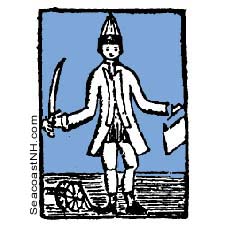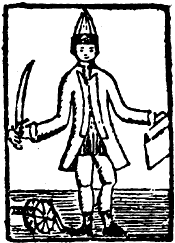| First US Navy Recruiting Poster |

1777 HISTORIC RANGER POSTER
It does promise you will see the world. It promises good pay, a fun time, and compensation if you are wounded or killed. Too bad most of the promises did not come true. But John Paul Jones was desperate to find a crew and get to France. It was 1777 in New Hampshire, and the Revolutionary War was on.
SEE: The 1777 poster and read text
Finding a Crew for the Ranger
Before he could sail Ranger from Portsmouth Harbor to battle the British, John Paul Jones needed to find a crew. Easier said than done. The Raleigh, among the very first US-made warships, had just been launched in Portsmouth and was in need of a crew. Privateering, with the promise of captured spoils was more appealing than the risk of serving on a military vessel -- and there were five privateer vessels in port at the time. To make matters worse, Jones was a Scot, a foreigner in a new land with an assumed name and a formal military bearing not often seen in these parts. He was officious, demanding, and itching for a battle. So Jones turned to advertising.
In July 1777, as Jones arrived in Portsmouth, New Hampshire, the United States was just one-year old. The locally-built Ranger was effectively a one-ship navy taking on the world's dominant maritime force, the British Royal Navy. It would depart for France in cold November weather, with an untried crew, not effectively rigged, and with 200 fewer kegs of rum than was usually required for a transatlantic crossing. The Ranger would engage the enemy. Men would die. Jones was fearful enough of the journey that he drafted his last will and testament just before departing.
But none of this was evident from Jones' recruitment poster, among the first in American military history. Even today, the illustrated broadside reads more like a travel brochure for a cruise to France, than a call to arms. Anticipating modern public relations-style recruiting that offers sailors the chance to see the world, Jones offered "great encouragement" to draw in his crewmen. The poster was distributed in Providence, Rhode Island and Boston, promising volunteer seamen would be cordially treated and well paid. He even hinted at the possibility of prize money, a promise that had caused him trouble with earlier crews and would do so again with the Ranger.
Despite all the publicity, two-thirds of Jones' crew of about 140 men and six officers came from the Piscataqua River region near Portsmouth. We know that Jones took out an ad in the local newspaper. Here crewmen were promised a bonus of $200 for the loss of a limb, or payment to their family in case of death. Jones wrote optimistically in a July letter to his friend Robert Morrs:
"I have now the fairest Prospects of getting the Ranger compleatly manned--hitherto the Seamen enter even to my wish--and if Cordage and other materials can be Procured--the Ranger will be at Sea before the Raleigh as the latter is an hundred Seamen short of the compliment--it is astonishing that so fine a Ship should lay by for want of Hands"
 But Jones had trouble soliciting sailors and even tried to get the fledgling NH government to draft soldiers from local forts to man the Ranger. By August Jones wrote to Congress for help in paying his men, at least those who had wives and children. Recruits were not being paid the sign-up money agreed to, and a 12-month term of duty was suddenly the requirement for payment. Jones feared that the men might think his handbill was deceitful advertising, and begged for payment to them. Congress, he was required to tell his men, had meant to give the advance payment for a term of three years. Despite the hyped recruitment poster, Jones wrote to say that he felt a personal obligation to the men who had trusted and joined him.
But Jones had trouble soliciting sailors and even tried to get the fledgling NH government to draft soldiers from local forts to man the Ranger. By August Jones wrote to Congress for help in paying his men, at least those who had wives and children. Recruits were not being paid the sign-up money agreed to, and a 12-month term of duty was suddenly the requirement for payment. Jones feared that the men might think his handbill was deceitful advertising, and begged for payment to them. Congress, he was required to tell his men, had meant to give the advance payment for a term of three years. Despite the hyped recruitment poster, Jones wrote to say that he felt a personal obligation to the men who had trusted and joined him.
By the last days of October Jones was distraught and angry. He had been "manned" he said for two months, and after delays of every kind from shipbuilder John Langdon, Jones was then forced to face a bout of bad weather. Perturbed at Langdon and at his low rank of office from the Continental Navy, Jones revised his story about finding a crew. In a letter he noted that he had experienced nothing but trouble in Portsmouth except for manning the ship. This, he wrote in October, was "no trouble" compared with getting payments, sails, rum, rank and other items that have slowed his mission to Europe.
The actual roster of the Ranger crew has never been found, but a list of about 140 men and six officers has been assembled from other records. All officers except Jones were politically connected to either Langdon, William Whipple or John Hancock, and were from the region. Among the crewmen were a few foreigners and two free black men from the region, Cato Calite and Scipio Africanus. According to biographer Samuel Eliot Morison, the final crew were advanced a total of $713 and Jones spent $542.12 1/2 recruiting them. Another $82.66 was paid out as "expenses in pursuit of deserters." Some of those men are buried today in obscure graves in Portsmouth's North Cemetery within sight of the Piscataqua River where the Ranger was launched.
By J. Dennis Robinson
© 1998 SeacoastNH.com
